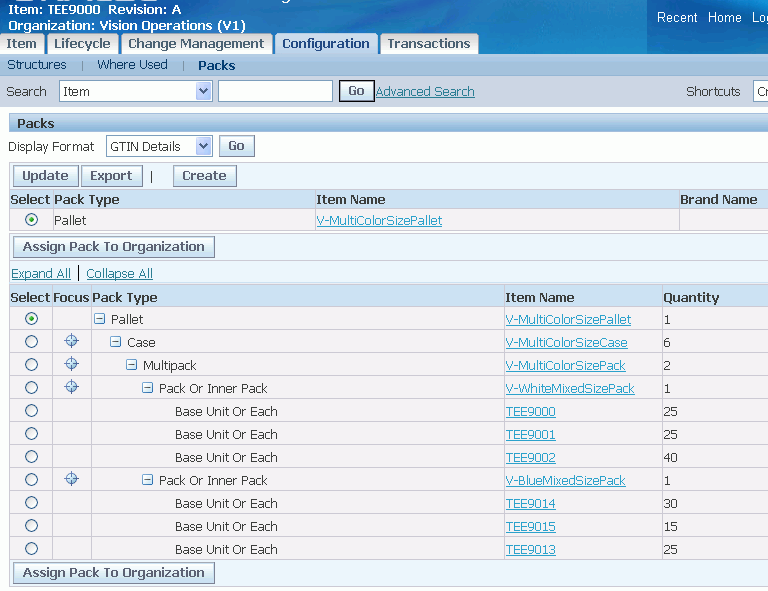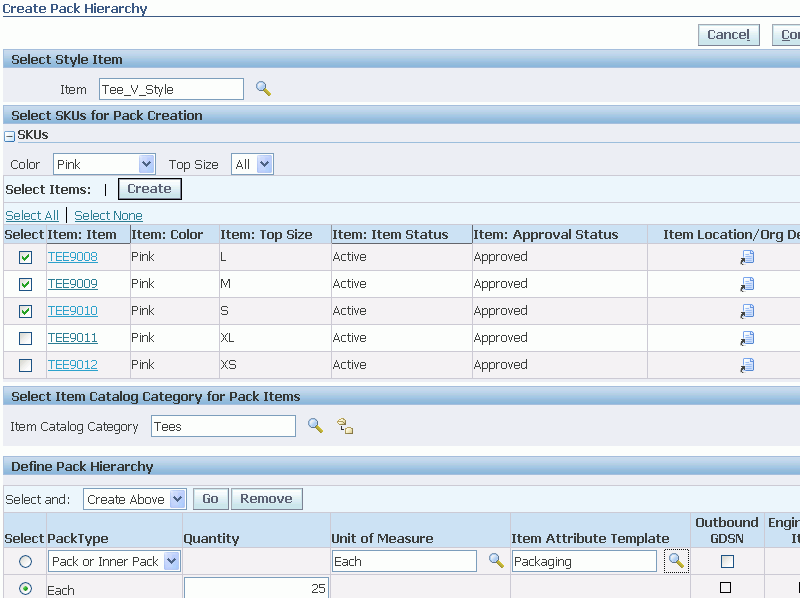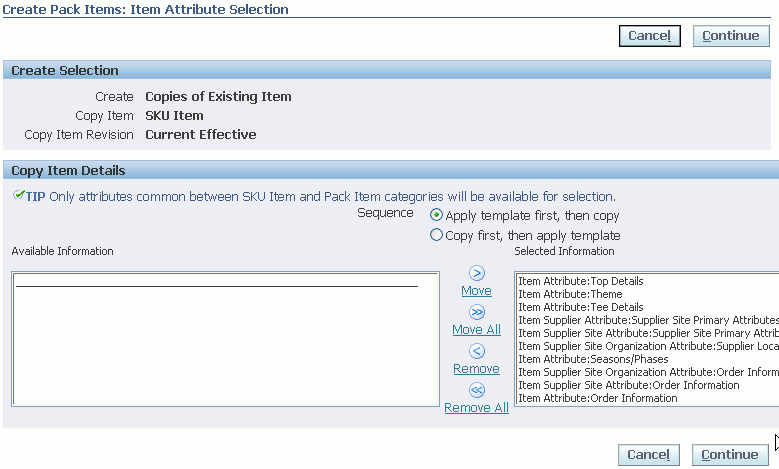Using Style and SKU Items
This chapter covers the following topics:
Overview of Style and SKU Items
You can use style items to group similar items (called SKUs or Stock Keeping Units) together. The items grouped under the style item (the SKUs) have variant attributes. For example, a retail clothing business sells a particular shirt style in multiple colors and sizes. The multiple colors represent one variant attribute group while the various sizes represent another variant attribute group. Variant attribute groups contain attributes that differentiate the item. Each unique variant combination represents a possible SKU item. A simple example that explains the use of style items with SKUs follows.
Style/SKU Example

The style item behaves as a model item while the SKUs behave as standard items. All business transactions occur at the SKU item level.
The SKUs can either inherit or default certain item characteristics from the style item. When a SKU inherits a characteristic from its style item, the characteristic is always controlled at the style item level. For example, you can only change an inherited item level user defined attribute such as price at the style item level. Once the price is changed, all SKUs reflect the new price. When a characteristic defaults from a style item to a SKU during SKU creation, you can change the characteristic at the SKU level later without affecting the style item. Conversely, if you change a defaulted characteristic at the style item level after SKU creation, the change does not automatically appear at the SKU level. You must manually make the change at the SKU level or use a mass update function to change the SKUs. See: Mass Updating Items, Item Categories and Item Associations. The following table lists the characteristics available to style and SKU items, as well as whether the inherit or default behavior is available for the characteristic.
| Characteristics | Style Item | SKU | Defaulting from Style to SKU | Inheritance from Style to SKU |
|---|---|---|---|---|
| Item level - User Defined Attributes | Yes | Yes | Yes | Yes |
| Item level - Retail Library defined attributes | Yes | Yes | Yes | Yes |
| Item level - Operational attributes | Yes | Yes | Yes | No |
| Variant Attribute Group | Yes | Yes | No | No |
| Revisions | Yes | Yes | No | No |
| Revision level User-defined attributes | Yes | Yes | No | No |
| Status | Yes | Yes | Yes | No |
| People/Security | Yes | Yes | Yes | No |
| Lifecycle | Yes | Yes | Yes | No |
| Retailer Sites | Yes | Yes | Yes | No |
| Item - Retailer Sites association attributes | Yes | Yes | Yes | Yes |
| Informal Pack Hierarchy | Yes | Yes | Yes* | Yes* |
| Formal Pack Hierarchy | Yes | Yes | No | not applicable |
| Structure/Bill of Material | Yes | Yes | No | No |
| Attachment - Item level | Yes | Yes | Yes | No |
| Attachment - Revision level | Yes | Yes | No | No |
| GTIN | Yes | Yes | No | No |
| Item Supplier associations | Yes | Yes | Yes | No |
| Change Management | Yes | Yes | not applicable | not applicable |
| External Transactions | not applicable | Yes | not applicable | not applicable |
| Related Items | Yes | Yes | No | No |
| Customer Item cross-reference | Yes | Yes | No | No |
| Manufacturer Part Number | Yes | Yes | No | No |
| Cross-Reference | Yes | Yes | No | No |
| Source System Cross-Reference | Yes | Yes | No | No |
| GDSN Syndicated Flag | No | Yes | not applicable | not applicable |
* for user defined attributes only
The style item and it's related SKUs must have the same item catalog category (ICC). You can only change a style items' ICC if there are no related SKUs or if you change the ICC using a mass update function to change the style and related SKUs ICC at the same time. See: Mass Updating Items, Item Categories and Item Associations.
Related Topics
Creating a SKU Packaging Hierarchy
Creating Style and SKU Items
You can use the same process to create style items as you do to create standard items. Once you create the style item, you have the option to immediately begin the SKU item creation flow from the style item's Overview page. In addition, you can create style and SKU items using the following methods:
-
Microsoft Office Excel spreadsheet (see: Importing Items Using a Spreadsheet)
-
Item Open Interface table (see: Managing Item Imports)
-
Import Workbench (see: Overview of Inbound Product Data Synchronization and Data Quality Management)
To create a style item
-
Create an item as described in Creating New Items with the following exceptions.
-
Select Style.
Caution: Once you create a style item, you cannot deselect Style. You also cannot change another type of item to a style item later. You can only create style items during the item creation process.
Note: You cannot create a GDSN Syndicated style item. The GDSN Syndicated box displays as read-only.
-
Optionally, select one or more templates that set the operational and user-defined attributes for the item.
Note: Each template selected is applied in the order listed. Templates applied latest override the attribute values of templates applied earlier.
-
In the Create Item: Enter Number/Description page, enter the item and item description.
Note: The system ignores the item number and description generation instructions specified by the item catalog category. Style item numbers and descriptions are user defined even if the item catalog category specifies 'Function Generated' or 'Inherited From Parent'.
Enter the following attributes, keeping in mind how the values entered effect the SKU items based on this style item.
-
Variant Attributes
The variant attribute groups listed default from the item catalog category selected. Variant attribute groups can have multiple value sets assigned to each group. For each group, select the value set to use when creating SKUs based on this style item.
-
You cannot select variant data types for Date, Date and Time, and Translatable Text.
-
You cannot enforce dependencies between value sets by using $ATTRIBUTEGROUP$ in the value set where clause for variant attribute groups, since they are static in nature.
-
-
Primary Attributes
Select the primary attribute values that you want the SKUs to either inherit or receive the default values.
Important: Verify that the following operational (transaction) attributes are set to No since style items are not transactable or stockable.:
-
Inventory Item
-
BOM Allowed
-
Build in WIP
-
Customer Orders Enabled
-
Internal Orders Enabled
-
Invoice Enabled
-
Transactable
-
Purchasable
-
Stockable
-
GDSN
The default value for these attributes is No, unless a template applied in the previous step sets their value to Yes.
-
-
Click Finish. The item Overview page displays.
To create SKU items from a style item
-
In the SKUs region, for each variant attribute, select the attribute value that you want to assign to the new SKU.
Tip: If you want to create a SKU for more than one variant attribute value, then select All for one or more attributes.
-
Click Create. The Create SKUs: Select Variants page appears.
-
For each variant attribute, select the values for which you want to create SKUs.
Note: You must select at least one value for each variant attribute.
-
Click Add Selected Variants to create the list of SKUs based on the variant attributes selected.
-
Select Outbound GDSN to GDSN-enable each SKU.
Caution: Oracle Product Information Management no longer supports outbound product data synchronization.
You cannot send data directly from Oracle Product Information Management (PIM) to the Global Data Synchronization Network (GDSN) since PIM only maintains the master data, but does not validate the data for GDSN. To send data to GDSN, you must build a validation or use a third party software application to perform this function.
-
Select Engineering Item if you want to create each SKU as an engineering item.
Leave this box blank to create the SKUs as production items.
-
Enter an item number and description for each SKU.
These fields already contain values if the item catalog category specifies function generated item numbers and descriptions. See: Defining Item Numbers and Descriptions, Oracle Product Information Management Implementation Guide.
-
Optionally, click Show in the Details column to change the primary attribute values for each SKU if these values defaulted from the style item.
If the SKU inherits the primary attribute values, then you cannot modify them.
Caution: The system only considers SKUs with a Trade Item Unit Descriptor (TIUD ) = Each or Base Unit for pack creation. See: Creating a SKU Packaging Hierarchy
-
Click Apply.
You receive a message saying that a batch has been submitted for SKU Creation. the message includes a link to the concurrent request ID.
To create SKU items after a new variant attribute value is added to the value set
Using the example of a shirt style in a retail clothing business, suppose the retailer plans to introduce a new shirt color, magenta, for spring. After the new color is added to the value set, you can create new SKUs for the magenta color.
Follow the steps to create SKU items from a style item as described above. The Create SKUs: Select Variants page, SKU Combinations region has a column titled "SKU Exists". If no checkmark exists in this column for the new SKU combination, you can create the new SKU. Enter the new SKU description and item number (unless the item number is sequence generated), then click Apply.
Update all SKU item operational attributes as necessary to make them stockable and transactable. You can manually update these attributes after SKU item creation from the SKU item's Overview page or you can perform a mass update. See:
Creating a SKU Packaging Hierarchy
You can package SKUs into multiple units of individual items. For example, a packaging hierarchy for different sizes and colors of v-neck t-shirts might contain the following pack types:
-
Pallet: Item = V-MultiColorSizePallet
-
Case: Item = V-MultiColorSizeCase, Quantity = 6
-
Multipack: Item = V-MultiColorSizePack, Quantity = 2
-
Pack or Inner Pack: Item = V-WhiteMixedSizePack, Quantity = 1
-
Base Unit or Each: Item = V-WhiteSmall, Quantity = 25
-
Base Unit or Each: Item = V-WhiteMedium, Quantity = 25
-
Base Unit or Each: Item = V-WhiteLarge, Quantity = 40
-
-
Pack or Inner Pack: Item = V-BlueMixedSizePack, Quantity = 1
-
Base Unit or Each: Item = V-BlueSmall, Quantity = 30
-
Base Unit or Each: Item = V-BlueMedium, Quantity = 15
-
Base Unit or Each: Item = V-BlueLarge, Quantity = 25
-
-
-
-
Use the following procedure to create a packaging hierarchy containing the SKUs. In the example above, this procedure creates the pack or inner pack item that contains either the white or blue v-neck t-shirt mixture of sizes. See: Managing the Packaging Hierarchy for instructions on how to create other levels of the packaging hierarchy.
Packaging Hierarchy Example

To create a SKU packaging hierarchy
-
Search for and select a style item.
-
In the Item Catalog, Item tab, Specifications subtab, Overview page, select Create Pack Hierarchy from the Actions menu. Click Go.
-
In the Create Pack Hierarchy page, select the SKUs that you want to include in a packaging hierarchy.
Tip: Use the variant attribute group pulldown lists to filter your list of SKU item choices.
-
Select the item catalog category for the new pack items.
All new items created are assigned to this item catalog category.
-
Select the lowest level pack type.
The lowest level (pack type) of a packaging hierarchy is the base unit (in most cases, Each).
Note: An item's pack type and Trade Item Unit Descriptor (TIUD) are synonymous with each other.
-
Select Create Above under the Define Pack Hierarchy region, then click Go.
-
For the new package level, specify the pack type, quantity, unit of measure, item attribute template, and whether the package level is an engineering item and outbound GDSN-enabled.
The quantity and unit of measure for a package level refer to the package level just below. For example, a pack or inner pack contains 25 each.

-
Once you have finished building the packaging hierarchy, click Continue.
-
In the Create Pack Items: Item Attribute Selection page, select the item details (such as attributes) to apply to the new pack item.
If you selected an item attribute template for the new pack type, you can choose whether to apply the template attribute values first or the attribute values common to both the SKU and pack item catalog categories first.
Click Continue.

-
In the Create Items: Enter Item/Description page, enter the item number and description for the new pack item, unless it is sequence or function generated. Click Finish.
Note: You only need to enter the item number and description for the new pack item in the first row of SKU items. The system ignores any item numbers and descriptions entered in later SKU item rows..
A concurrent request program launches to create the new pack item. You receive a concurrent request ID. After the concurrent request processes successfuly, you can search for the new pack item and view it as you would view any other item.


Related Topics